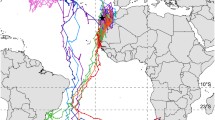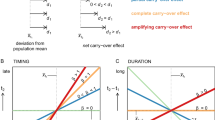Abstract
Weather conditions are paramount in shaping birds’ migratory routes, promoting the evolution of behavioural plasticity and allowing for adaptive decisions on when to depart or stop during migration. Here, we describe and analyze the influence of weather conditions in shaping the sea-crossing stage of the pre-breeding journey made by a long-distance migratory bird, the Eleonora’s falcon (Falco eleonorae), tracked by satellite telemetry from the wintering grounds in the Southern Hemisphere to the breeding sites in the Northern Hemisphere. As far as we know, the data presented here are the first report of repeated oceanic journeys of the same individuals in consecutive years. Our results show inter-annual variability in the routes followed by Eleonora’s falcons when crossing the Strait of Mozambique, between Madagascar and eastern continental Africa. Interestingly, our observations illustrate that individuals show high behavioural plasticity and are able to change their migration route from one year to another in response to weather conditions, thus minimising the risk of long ocean crossing by selecting winds blowing towards Africa for departure and changing the routes to avoid low pressure areas en route. Our results suggest that weather conditions can really act as obstacles during migration, and thus, besides ecological barriers, the migratory behaviour of birds could also be shaped by “meteorological barriers”. We briefly discuss orientation mechanisms used for navigation. Since environmental conditions during migration could cause carry-over effects, we consider that forecasting how global changes of weather patterns will shape the behaviour of migratory birds is of the utmost importance.

Similar content being viewed by others

References
Agostini N, Premuda G, Mellone U, Panuccio M, Logozzo D, Bassi E, Cocchi L (2005) Influence of wind and geography on orientation behavior of adult Honey Buzzards Pernis apivorus during migration over water. Acta Ornithol 40:71–74
Agostini N, Cardelli C, Gustin M (2007) Factors shaping pathways of European Honey-buzzards (Pernis apivorus) during spring migration in the Central Mediterranean basin. J Raptor Res 41:57–61
Akesson S, Hedenström A (2007) How migrants get there: migratory performance and orientation. BioScience 57:123–133
Alerstam T (1981) The course and timing of bird migration. In: Aidley DJ (ed) Animal migration. Cambridge University Press, Cambridge, pp 9–54
Alerstam T, Petterson SG (1976) Do birds use waves for orientation when migrating across the sea? Nature 259:205–207
Alerstam T, Hake M, Kjellén N (2006) Temporal and spatial patterns of repeated migratory journeys by ospreys. Anim Behav 71:555–566
Argos (2008) User’s manual. CLS/Service Argos, Toulouse
Batchelor GK (2000) An introduction to fluid dynamics. Cambridge University Press, Cambridge
Batschelet E (1981) Circular statistics in biology. Academic, London
Bildstein KL (2006) Migrating raptors of the world. Cornell University Press, Ithaca
Delingat J, Bairlein F, Hedenström A (2008) Obligatory barrier crossing and adaptive fuel management in migratory birds: the case of the Atlantic crossing in Northern Wheatears (Oenanthe oenanthe). Behav Ecol Sociobiol 62:1069–1078
Elkins N (1988) Weather and bird behaviour. Poyser, Calton
Felicísimo ÁM, Muñoz J, González-Solis J (2008) Ocean surface winds drive dynamics of transoceanic aerial movements. PLoS ONE 3(8):e2928. doi:10.1371/journal.pone.0002928
Ferguson-Lees J, Christie DA (2001) Raptors: birds of prey of the world. Black, London
Gill RE, Tibbitts TL, Douglas DC, Handel CM, Mulcahy DM, Gottschalck JC, Warnock N, McCaffery BJ, Battley PF, Piersma T (2009) Extreme endurance flights by landbirds crossing the Pacific Ocean: ecological corridor rather than barrier? Proc R Soc Lond B 276:447–457
Gschweng M, Kalko EKV, Querner U, Fiedler W, Berthold P (2008) All across Africa: highly individual migration routes of Eleonora’s falcon. Proc R Soc Lond B 275:2887–2896
Hedenström A (2010) Extreme endurance migration: what is the limit to non-stop flight? PLoS Biology 8:e1000362. doi:10.1371/journal.pbio.1000362
Higuchi H, Shiu HJ, Nakamura H, Uematsu A, Kuno K, Saeki M, Hotta M, Tokita KI, Moriya E, Morishima E, Tamura M (2005) Migration of honey buzzards Pernis apivorus based on satellite tracking. Ornithol Sci 4:109–115
Kalnay E et al (1996) The NCEP/NCAR 40-year reanalysis project. Bull Am Meteorol Soc 77:437–470
Kenward R (ed) (2001) A manual for wildlife radio tagging. Academic, London
Kerlinger P (1989) Flight strategies of migrating hawks. University of Chicago Press, Chicago
Klaassen RHG, Strandberg R, Hake M, Olofsson P, Tøttrup AP, Alerstam T (2010) Loop migration in adult marsh harriers Circus aeruginosus, as revealed by satellite telemetry. J Avian Biol 41:200–207
Liechti F (2006) Birds: blowin’ by the wind? J Orn 147:202–211
López-López P, Limiñana R, Urios V (2009) Autumn migration of Eleonora’s falcon Falco eleonorae tracked by satellite telemetry. Zool Stud 48:485–491
López-López P, Limiñana R, Mellone U, Urios V (2010) From the Mediterranean Sea to Madagascar. Are there ecological barriers for the long-distance migrant Eleonora’s falcon? Land Ecol 25:803–813
McGrady MJ, Young GS, Seegar WS (2006) Migration of a Peregrine Falcon Falco peregrinus over water in the vicinity of a hurricane. Ring Mig 23:80–84
Meyer SK, Spaar R, Bruderer B (2000) To cross the sea or to follow the coast? Flight directions and behaviour of migrating raptors approaching the Mediterranean Sea in autumn. Behaviour 137:379–399
Navedo JG, Masero JA, Overdijk O, Orizaola G, Sánchez-Guzmán JM (2010) Assessing the role of multiple environmental factors on Eurasian Spoonbill departure decisions from stopover sites. Ardea 98:3–12
Newton I (2008) The migration ecology of birds. Academic, London
Pulido F, Berthold P (2010) Current selection for lower migratory activity will drive the evolution of residency in a migratory bird population. Proc Natl Acad Sci USA 107:7341–7346
Richardson WJ (1978) Timing and amount of bird migration in relation to weather: a review. Oikos 30:224–272
Robinson RA, Crick HQP, Learmonth JA, Maclean IMD et al (2009) Travelling through a warming world: climate change and migratory species. Endanger Species Res 7:87–99
Rosén M, Hedenstrom A, Badami A, Spina F, Akesson S (1999) Hunting flight behaviour of the Eleonora’s falcon Falco eleonorae. J Avian Biol 30:342–350
Saino N, Rubolini D, von Hardenberg J, Ambrosini R, Provenzale A, Romano M, Spina F (2010) Spring migration decisions in relation to weather are predicted by wing morphology among trans-Mediterranean migratory birds. Func Ecol 24:658–669. doi:10.1111/j.1365-2435.2009.01659.x
Shamoun-Baranes J, Baharad A, Alpert P, Berthold P, Yom-Tov Y, Dvir Y, Leshem Y (2003) The effect of wind, season and latitude on the migration speed of white storks Ciconia ciconia, along the eastern migration route. J Avian Biol 34:97–104
Stutchbury BJM, Tarof SA, Done T, Gow E, Kramer PM, Tautin J, Fox JW, Afanasyev V (2009) Tracking long-distance songbird migration by using geolocators. Science 323:896
Strandberg R, Klaassen RHG, Hake M, Alerstam T (2009) How hazardous is the Sahara Desert crossing for migratory birds? Indications from satellite tracking of raptors. Biol Lett 6:297–300. doi:10.1098/rsbl.2009.0785
Thorup K, Alerstam T, Hake M, Kjellén N (2003) Bird orientation: compensation for wind drift in migrating raptors is age dependent. Proc R Soc Lond B 270(Suppl):S8–S11
Walter H (1979) Eleonora’s falcon. Adaptations to prey and habitat in a social raptor. University of Chicago Press, Chicago
Zar JH (1984) Biostatistical analysis. Prentice-Hall, New York
Zu-Aretz S, Leshem Y (1983) The sea—a trap for gliding birds. Torgos 5:16–17
Acknowledgements
The Terra Natura Foundation and the “Servei de Biodiversitat” of the “Conselleria de Medi Ambient” (Generalitat Valenciana) financed this project. Special thanks are due to J. Jiménez, J.V. Escobar, J. Mayol and J. Muntaner. J. De la Puente, A. Bermejo, E. Escudero (SEO-Monticola), J.L. Martínez, M. Suárez, T. Muñoz (GOB), V. Ferrís, E. Sánchez, B. Sarzo and M.A. Bartolomé helped in trapping activity. Two anonymous referees made valuable suggestions that improved the paper. P.L.-L. and U.M. are supported by FPU grants of the Spanish Ministry of Education (references AP2005-0874 and AP2008-0947). This paper is part of the PhD dissertation of U.M. and it complies the current laws in Spain.
Author information
Authors and Affiliations
Corresponding author
Rights and permissions
About this article
Cite this article
Mellone, U., López-López, P., Limiñana, R. et al. Weather conditions promote route flexibility during open ocean crossing in a long-distance migratory raptor. Int J Biometeorol 55, 463–468 (2011). https://doi.org/10.1007/s00484-010-0368-3
Received:
Revised:
Accepted:
Published:
Issue Date:
DOI: https://doi.org/10.1007/s00484-010-0368-3



